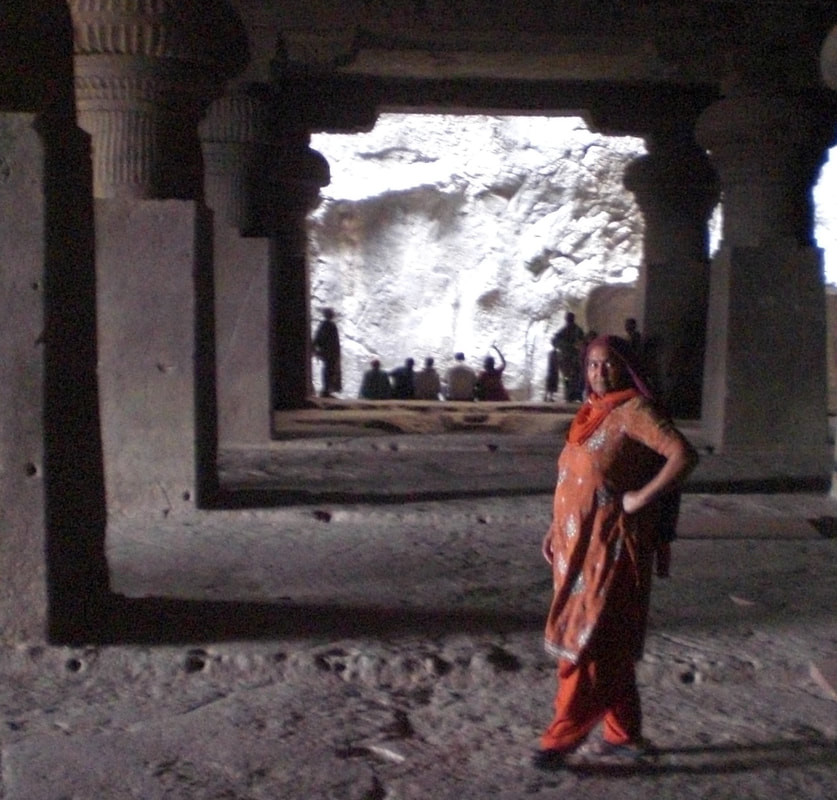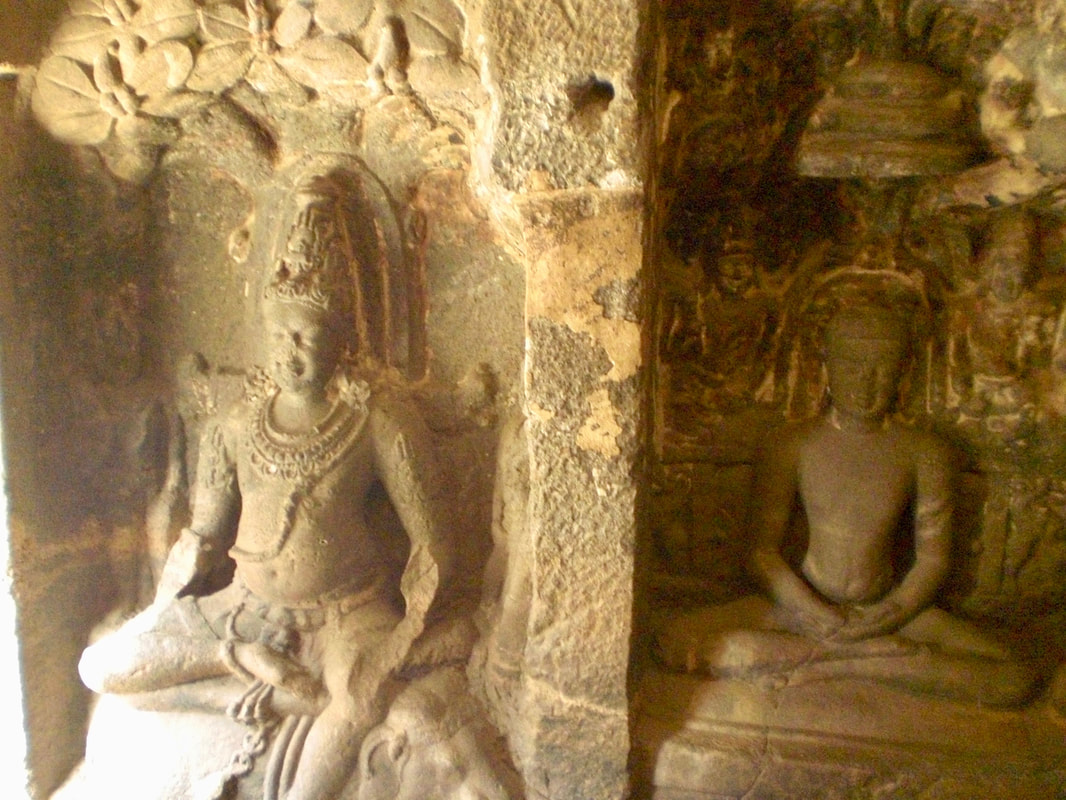1. Accumulation - Sañchaya
2. Aggravation - Prakopa
3. Overflow - Prasara
4. Relocation - Sthāna Samshraya
5. Manifestation - Vyakti
6. Diversification - Bheda.
Accumulation, or Doshic Sañchya denotes the first level of imbalance. In this stage an excess of Vāta, Pitta, or Kapha accumulate in their own sites, the colon (Vāta), small intestine (Pitta) and stomach (Kapha) respectively. As this disturbance is in this very early stage, symptoms tend to be mild and intermittent, so it may not be obvious.
Vāta accumulation may show itself as mild constipation or abdominal distension due to excessive gas in the colon. Pitta excess may be noted by symptoms such as dark yellow urine, yellow discoloration in the sclera of the eyes and excessive heat. Kapha buildup may manifest as full stomach, low appetite, heaviness in the limbs and general lethargy.
At this stage, one can tune into what is happening by simply listening to one's own innate body intelligence. You are not ill just slightly out of balance. For instance it could have been the case that for the past few days you have been eating too much ice cream, Kapha has built up in the stomach and started to cause an imbalance. If you listen to your body’s innate intelligence, there may be a desire to eat hot spicy food to burn off the Kapha and counteract this.
Aggravation or Prakopa is the next level down the scale of wellbeing. If the aggravating influences are not noticed in the accumulation stage of illness and allowed to go unchecked, the doshas become overloaded in their respective sites and disturbance occurs. An example of this is indigestion and mild gut provocation. You may go out and eat a heavy meal rather late in the evening. Next day you wake up and feel congestion and fullness in the alimentary canal. When the telephone rings and your best mate asks you down the pub for pies and pints, you are still feeling the effects from the day before. It is little wonder that you end up feeing more overstuffed and bloated, other physical symptoms may also concurrently arise. Cough and congestion may occur as Kapha moves upwards into the respiratory tract. Excess Pitta may lead to indigestion and excess Vāta, can lead to back pain, hyperperistalsis and wind. This can generally be solved without consulting a health professional, as all you need to do is remove the cause, which in this case is too much of the wrong foods and nature should reward you by letting you get back to good health. It is when you don’t listen to nature that the problem worsens. If the warnings are not heeded and the disease process has gone too far, it cannot be contained in the primary Doshic sites and it spreads around the body to other areas.
2. Aggravation - Prakopa
3. Overflow - Prasara
4. Relocation - Sthāna Samshraya
5. Manifestation - Vyakti
6. Diversification - Bheda.
Accumulation, or Doshic Sañchya denotes the first level of imbalance. In this stage an excess of Vāta, Pitta, or Kapha accumulate in their own sites, the colon (Vāta), small intestine (Pitta) and stomach (Kapha) respectively. As this disturbance is in this very early stage, symptoms tend to be mild and intermittent, so it may not be obvious.
Vāta accumulation may show itself as mild constipation or abdominal distension due to excessive gas in the colon. Pitta excess may be noted by symptoms such as dark yellow urine, yellow discoloration in the sclera of the eyes and excessive heat. Kapha buildup may manifest as full stomach, low appetite, heaviness in the limbs and general lethargy.
At this stage, one can tune into what is happening by simply listening to one's own innate body intelligence. You are not ill just slightly out of balance. For instance it could have been the case that for the past few days you have been eating too much ice cream, Kapha has built up in the stomach and started to cause an imbalance. If you listen to your body’s innate intelligence, there may be a desire to eat hot spicy food to burn off the Kapha and counteract this.
Aggravation or Prakopa is the next level down the scale of wellbeing. If the aggravating influences are not noticed in the accumulation stage of illness and allowed to go unchecked, the doshas become overloaded in their respective sites and disturbance occurs. An example of this is indigestion and mild gut provocation. You may go out and eat a heavy meal rather late in the evening. Next day you wake up and feel congestion and fullness in the alimentary canal. When the telephone rings and your best mate asks you down the pub for pies and pints, you are still feeling the effects from the day before. It is little wonder that you end up feeing more overstuffed and bloated, other physical symptoms may also concurrently arise. Cough and congestion may occur as Kapha moves upwards into the respiratory tract. Excess Pitta may lead to indigestion and excess Vāta, can lead to back pain, hyperperistalsis and wind. This can generally be solved without consulting a health professional, as all you need to do is remove the cause, which in this case is too much of the wrong foods and nature should reward you by letting you get back to good health. It is when you don’t listen to nature that the problem worsens. If the warnings are not heeded and the disease process has gone too far, it cannot be contained in the primary Doshic sites and it spreads around the body to other areas.
Overflow or Prasara is the next stage. If the Doshas continue to be subjected to further stress, disorder can start to spread around the whole body. The Doshas leave their respective sites in the gut and start to spread to sites in other parts of the body to which they have an affinity. This leads to the individual experiencing prodromal signs and symptoms known in Sanskrit as Purva Rupa. Purva Rupa forms the junction between the three less serious stages of disease and the three more worrying ones. When the Doshas are in the early stages of accumulation and provocation, they can be dealt with by listening to the body’s innate intelligence and reversing the effects by doing the opposite to settle things down. For instance, if you have eaten too much spicy food you will normally crave a cooling influence such as yogurt. But as soon as we enter the Prasara or spreading phase of disorder, the Doshas start to behave in a naughty way and actually create like cravings, so if you have indulged in too much spicy food you will want more of it! Matters become paradoxical. One problem with the western diet is too much refined sugar. Sugar cravings can have both physiological and psychological elements to them. If gut dysbiosis has arisen because of an excess of candida, then as the candida proliferates more and more, the person will crave more sugar, as this is what the yeast infection requires to feed and sustain itself. It literally tricks the body into craving sugar to continue it's parasitic existence. Obviously this further aggravates the situation and you end up feeling even worse. So in a nutshell, during Prasara your bodily wants and perceived needs are perverted away from balancing things out and towards feeding the progress of the disease. The old and often utilized piece of advice - “don’t beat yourself up”, immediately comes to mind.
During Prasara, the question is where do the unbalanced disturbed Doshas specifically travel to? Well Vāta will leave the colon and enter the general circulation. It gravitates towards its associated secondary sites, such as, the skin, ears, bones and thighs. Typical prodromal symptoms that present are dry skin, goose bumps, cold hands and feet, ringing in the ears, tingling, numbness and quivering thighs and other “dry” symptoms. Pitta moves from the small intestine to secondary sites such as the stomach, eyes, sweat glands, skin, heart and subcutaneous fat. This can cause heartburn, burning eyes, acidic sweat, hives, rashes, urticarial burning sensations and other “hot” prodromal symptoms. Kapha travels from the stomach to the lungs, sinuses, lymphatic system, breast tissue, mouth and head. This leads to “wet” prodromal symptoms, factors such as water congestion, sinus congestion, lymphatic congestion, heavy breasts, excessive salivation, heaviness in the head and cold clammy skin. Vāta is always involved in Prasara whatever Dosha has become fundamentally unbalanced, as Vāta’s energy and movement is essential at carrying Pitta and Kapha to their respective secondary sites.
The next stage is Relocation, known in Ayurveda as Sthāna Samshraya. This is when the aggravated Dosha seeks out the weakest point in the target area to settle. Ayurvedic physicians refer to these weak spots as Khavaigunyas. The weakness may have arisen from either genetic or environmental trauma and weakened through deficiency of nutrition, toxicity of the tissues, or a mixture of both. The weakness can be a result of physical and emotional trauma disrupting the physiology in numerous ways. We can liken Khavaigunyas to open doors, where the Doshas can just walk in as they wish and cause damage. This amalgamation of Doshas and body tissues (Dahatus) is the forth stage of ill health and disease begins to proliferate. The immune system must be really strong to counteract this and pacify the Dosha sufficiently, so it will return to its respective seat in the GI tract. If this doesn’t happen and the Dosha is stronger than the body defenses, then disease will manifest as the condition worsens and increasing damage to the tissues results. Prodromal signs and symptoms are clearly seen at this stage. An alert person can feel that something is starting to go wrong with them and an alert practitioner can address this holistically, support the immune system and try to regress the progress of disease and disorder.
During Prasara, the question is where do the unbalanced disturbed Doshas specifically travel to? Well Vāta will leave the colon and enter the general circulation. It gravitates towards its associated secondary sites, such as, the skin, ears, bones and thighs. Typical prodromal symptoms that present are dry skin, goose bumps, cold hands and feet, ringing in the ears, tingling, numbness and quivering thighs and other “dry” symptoms. Pitta moves from the small intestine to secondary sites such as the stomach, eyes, sweat glands, skin, heart and subcutaneous fat. This can cause heartburn, burning eyes, acidic sweat, hives, rashes, urticarial burning sensations and other “hot” prodromal symptoms. Kapha travels from the stomach to the lungs, sinuses, lymphatic system, breast tissue, mouth and head. This leads to “wet” prodromal symptoms, factors such as water congestion, sinus congestion, lymphatic congestion, heavy breasts, excessive salivation, heaviness in the head and cold clammy skin. Vāta is always involved in Prasara whatever Dosha has become fundamentally unbalanced, as Vāta’s energy and movement is essential at carrying Pitta and Kapha to their respective secondary sites.
The next stage is Relocation, known in Ayurveda as Sthāna Samshraya. This is when the aggravated Dosha seeks out the weakest point in the target area to settle. Ayurvedic physicians refer to these weak spots as Khavaigunyas. The weakness may have arisen from either genetic or environmental trauma and weakened through deficiency of nutrition, toxicity of the tissues, or a mixture of both. The weakness can be a result of physical and emotional trauma disrupting the physiology in numerous ways. We can liken Khavaigunyas to open doors, where the Doshas can just walk in as they wish and cause damage. This amalgamation of Doshas and body tissues (Dahatus) is the forth stage of ill health and disease begins to proliferate. The immune system must be really strong to counteract this and pacify the Dosha sufficiently, so it will return to its respective seat in the GI tract. If this doesn’t happen and the Dosha is stronger than the body defenses, then disease will manifest as the condition worsens and increasing damage to the tissues results. Prodromal signs and symptoms are clearly seen at this stage. An alert person can feel that something is starting to go wrong with them and an alert practitioner can address this holistically, support the immune system and try to regress the progress of disease and disorder.
Manifestation or Vyakti is the fifth stage of disease. Cardinal signs and symptom of disease can be observed. The unleashed Doshas suppress the natural qualities of resistance in the tissues resulting in recognizable pathology. The pathology may be mono, dual or tri Doshic. An example of this can be seen by studying different presentations of arthritis:- Vāta arthritic symptoms are pain and joint stiffness and deformation of the articular surfaces of the joints. Pitta arthritic symptoms are inflammation, irritation and burning. Kapha symptoms will present as stagnation, congestion and swelling in the joint and within the surrounding soft tissues. Some people will have all of these symptoms and have tri- Doshic arthritis, whereas others have either a single Doshic arthritis, or demonstrate Doshic duality. One thing however is certain, proper intervention and the skills of a competent professional are certainly needed.
The final stage of disease is known as Diversification or Bheda. In this stage, it is not only the initially disturbed tissues that are affected and structurally compromised; the disease has started to spread deeper with severe complications, function is compromised. For instance if there is Vāta arthritis, not only the joint space suffers, but there are also complications to the surrounding soft tissues, leading to such problems as muscle wasting, frozen joints and deformity. In this stage, both structure and function are affected and the individual is without doubt very ill and in need of intervention to rectify matters. Vãta during the Bheda stage of disease can cause structural changes depending on the disorder manifested and the part of the body that is undergoing advanced affliction. Symptoms that may be observed include, severe dehydration, emaciation, degeneration, osteoporosis and muscle wasting. The tissues show a tendency to being stiff, dry and hard. Pitta during Bheda shows up symptoms such as ulceration, hemorrhage, perforation, suppuration and pus formation. Kapha will display tumor formations, engorgement of tissues and cells become bloated with interstitial fluid. Lipoma, fibroma, myoma and osteoma are all Kapha phenomena.
To explore this concept in more detail, see Volume 2, Textbook Of Ayurveda - published 2006 Ayurvedic Press by Dr. Vasant Lad. Or e-mail myself and discuss.
The final stage of disease is known as Diversification or Bheda. In this stage, it is not only the initially disturbed tissues that are affected and structurally compromised; the disease has started to spread deeper with severe complications, function is compromised. For instance if there is Vāta arthritis, not only the joint space suffers, but there are also complications to the surrounding soft tissues, leading to such problems as muscle wasting, frozen joints and deformity. In this stage, both structure and function are affected and the individual is without doubt very ill and in need of intervention to rectify matters. Vãta during the Bheda stage of disease can cause structural changes depending on the disorder manifested and the part of the body that is undergoing advanced affliction. Symptoms that may be observed include, severe dehydration, emaciation, degeneration, osteoporosis and muscle wasting. The tissues show a tendency to being stiff, dry and hard. Pitta during Bheda shows up symptoms such as ulceration, hemorrhage, perforation, suppuration and pus formation. Kapha will display tumor formations, engorgement of tissues and cells become bloated with interstitial fluid. Lipoma, fibroma, myoma and osteoma are all Kapha phenomena.
To explore this concept in more detail, see Volume 2, Textbook Of Ayurveda - published 2006 Ayurvedic Press by Dr. Vasant Lad. Or e-mail myself and discuss.



 RSS Feed
RSS Feed
